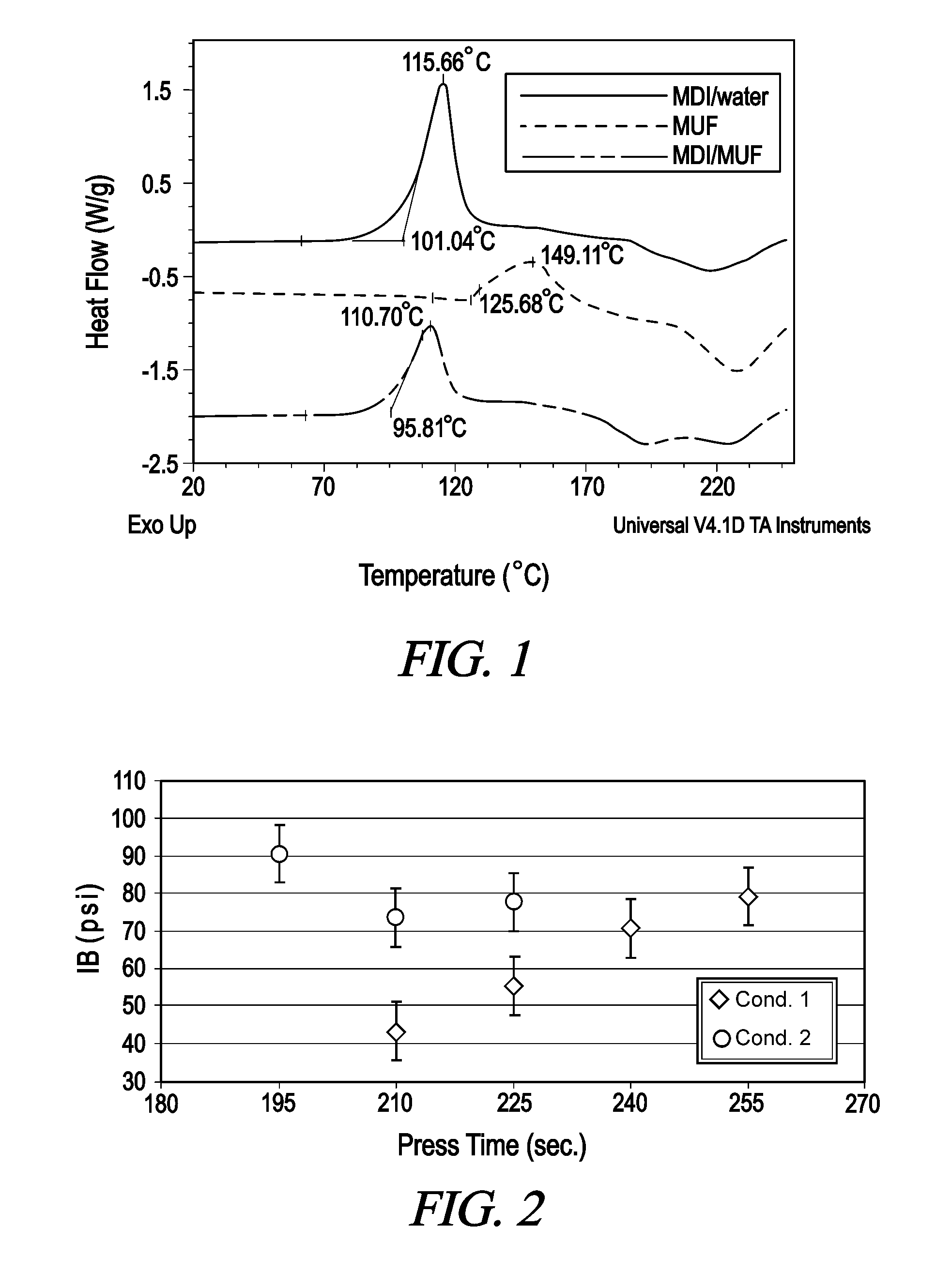Accelerated Curing Adhesive For Wood Composites
a wood composite and accelerated curing technology, applied in the field of adhesives, can solve the problems of increasing the emission of volatile organic compounds (vocs), hazardous air pollutants, and the inability of phenol formaldehyde resins to consistently bond wood panels of high moisture content, and achieve the effects of improving the process of creating wood-based composite materials, reducing emissions, and fast cure ra
- Summary
- Abstract
- Description
- Claims
- Application Information
AI Technical Summary
Benefits of technology
Problems solved by technology
Method used
Image
Examples
example 1
[0042]Two facing veneers are painted with resin to simulate bonding characteristics at the core of a portion of OSB. A sandwich is formed with two unresinated veneers on the outer surfaces and the two facing veneers in between with the four veneers having a thickness of about 0.60″ that is pressed to stops at 0.40″. Table 1 illustrates that substitution over a wide range of MUF resin yields a well-bonded board when pressed under mild conditions, 350° F. for a press time of 115 seconds, whereas MDI alone did not bond at all alone. As is further illustrated, a 1% addition of a formaldehyde-containing resin accelerator provided adequate bonding.
TABLE 1In-Press Bonding Performance at 350° F. and 115Minute Press timeResinIn-press BondingMDINoneMDI with 1% SA-102 catalystAdequateMDI with 2% triethylamineAdequateMDI with 15% MUF liquidAdequateMDI with 5% MUF liquidAdequateMDI with 5% MUF liquidAdequateMDI with 5% waterSlight
[0043]In addition, FIG. 1 attached hereto illustrates how the prac...
example 2
[0045]Three-layer strand boards are made as follows. The surface layers constitute 60% of the total board weight, while the core layer constitutes 40% of the weight. Southern Yellow Pine strands are obtained from an OSB mill. The strands are screened and dried to 9-11% moisture content, and then blended with a pMDI resin (with and without an accelerator) and a wax emulsion. Wax is added at 0.7% rate, based on oven-dried wood weight. The resin and accelerator application rates (based on oven-dried wood weight) are shown in Table 2.
TABLE 2Condition #Face ResinCore ResinCore Accelerator12% pMDI2% pMDINone22% pMDI2% pMDI0.3% MUF
[0046]The boards are pressed at 330° F. for various press times to a target density of 40 pcf and a target thickness of 23 / 32″. The boards are then tested for internal bond (IB) strength. The results are shown in FIG. 2. The results demonstrate that the addition of the accelerator increased the cure speed of the resin system.
[0047]The above examples illustrate th...
PUM
 Login to View More
Login to View More Abstract
Description
Claims
Application Information
 Login to View More
Login to View More - R&D
- Intellectual Property
- Life Sciences
- Materials
- Tech Scout
- Unparalleled Data Quality
- Higher Quality Content
- 60% Fewer Hallucinations
Browse by: Latest US Patents, China's latest patents, Technical Efficacy Thesaurus, Application Domain, Technology Topic, Popular Technical Reports.
© 2025 PatSnap. All rights reserved.Legal|Privacy policy|Modern Slavery Act Transparency Statement|Sitemap|About US| Contact US: help@patsnap.com

